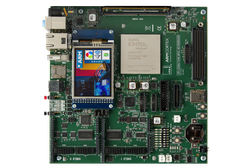ARM V2M-MPS3
The MPS3 motherboard is an FPGA Internet of Things (IoT) development platform. The board is designed to support ARM Cortex®-M class and small to medium ARM Cortex-A and Cortex-R class processors, or dedicated custom designs.

Subsystem Information¶
The MPS3 motherboard is an FPGA Internet of Things (IoT) development platform. The board is designed to support ARM Cortex®-M class and small to medium ARM Cortex-A and Cortex-R class processors, or dedicated custom designs.
Major features of the MPS3 motherboard¶
The MPS3 motherboard contains a Xilinx Kintex Ultrascale XCKU115-1FLVB1760C FPGA, support logic, and peripheral interfaces that provide access to the FPGA and I/O interfaces.
The feature-rich set of user peripherals connects directly to the FPGA and provides flexibility for the user. The peripherals can be included in a custom design as required.
Two Arduino expansion Shield slots enable connection of sensors, motors, and other design-specific peripherals. The MPS3 motherboard also provides expansion through four Peripheral Module (Pmod) expansion ports, and an FPGA Mezzanine Card High-Pin Count (FMC-HPC) expansion port.
An on-board Motherboard Configuration Controller (MCC) controls the motherboard and configures the FPGA in a way similar to other boards in the ARM Versatile™ Express range.
Uses of the MPS3 motherboard¶
The MPS3 motherboard enables FPGA prototyping of complex designs:
- Software development:
- Linux development on Cortex-A or Cortex-R class processors.
- mbedOS/Cortex Microcontroller Software Interface Standard (CMSIS)/Real-Time Operating System (RTOS) development on Cortex-M class processors.
- Bare metal development.
- Tool development.
Features¶
The MPS3 motherboard provides:
- One Kintex XCKU115 FPGA.
- Board interfaces:
- Ethernet 10/100.
- AC97 audio.
- HDMI video up to 1080p.
- Dual USB-A port.
- Expansion connectivity:
- Two Arduino Shield interfaces for custom peripherals.
- FMC-HPC expansion for up to 160 I/O, 10 multi-GigaBit Transceivers (GBT), and clocks.
- Four Pmod interfaces.
- Quarter Video Graphics Array (QVGA) CLCD with touchscreen.
- Memory:
- 4GB DDR4 with capacity for up to 8GB.
- 8MB user Quad Serial Peripheral Interface (QSPI) flash for boot.
- Up to 8MB of FPGA Block RAM (BRAM).
- 16GB eMMC.
- microSD card interface.
- Clocks:
- Real-Time Clock (RTC).
- Five programmable clocks.
- One fixed 24MHz clock.
- User board components:
- Ten user LEDs.
- Eight user switches.
- Two user push buttons.
- Reset push buttons and power indicator LEDs.
- Debug support:
- P-JTAG processor debug.
- F-JTAG (FPGA) debug.
- Serial Wire Debug (SWD).
- 16-bit trace.
- 4-bit trace.
- On-board CMSIS-DAP.
- Four serial ports over USB.
I/O Connections¶

You need to log in to post a discussion
